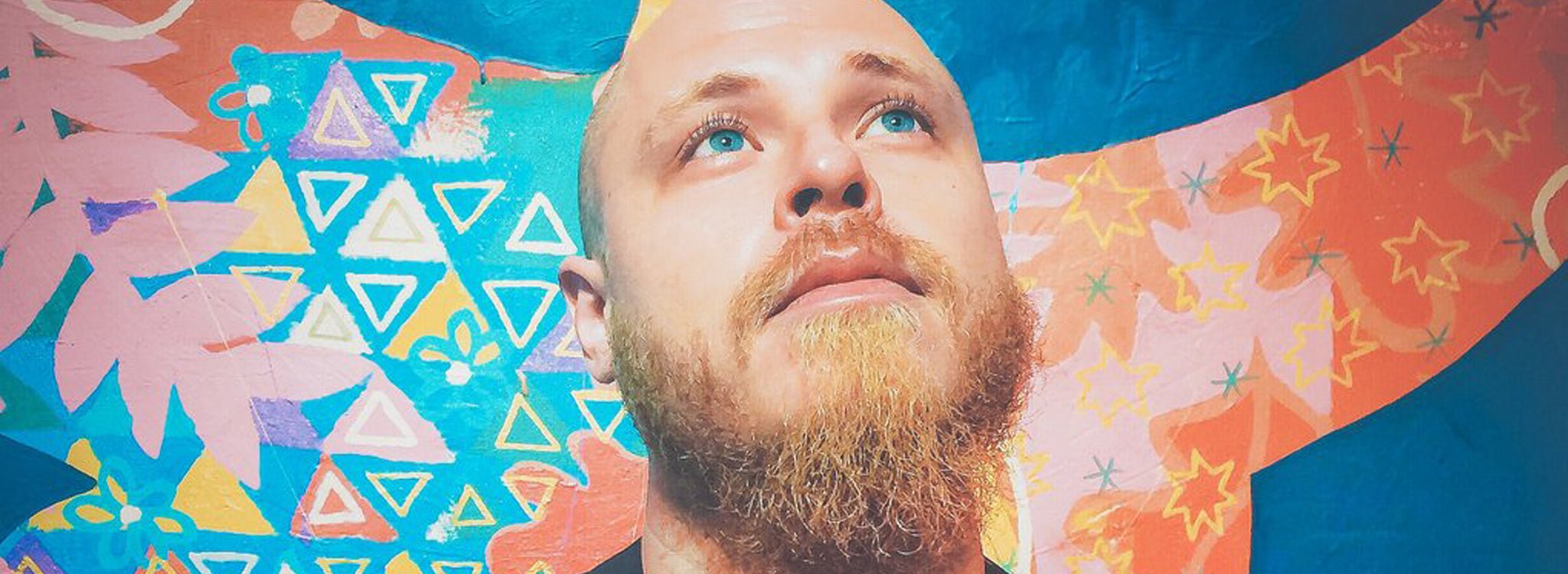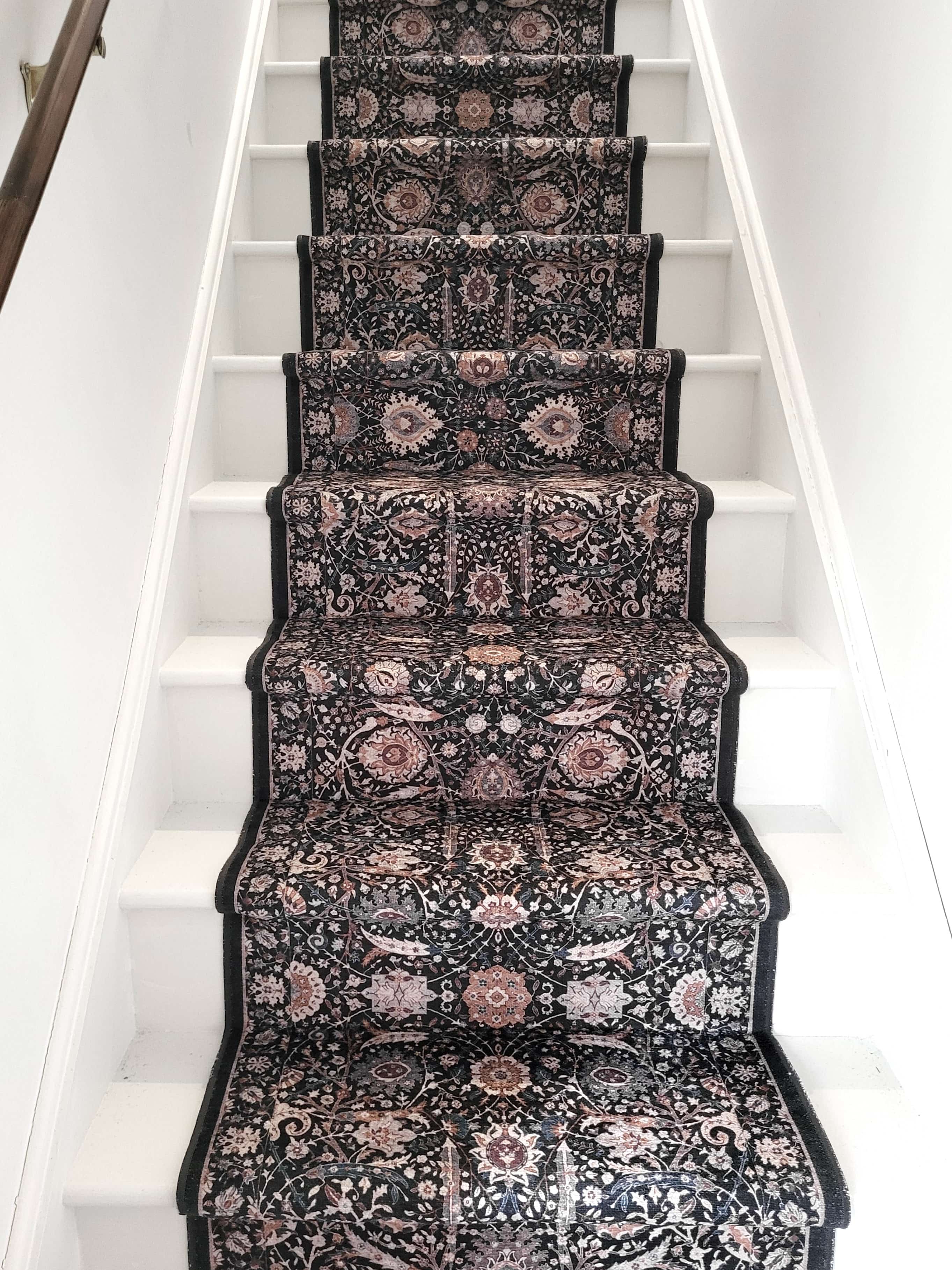Hop on the rug with us - and get to know how painter and new dad Misha Tyutyunik lives life well.
You could say Misha Tyutyunik has been interested in art his whole life. The 38-year-old illustrator, painter, muralist and virtual reality artist always remembers doing it – and loving it. “We all draw and make art as children,” he says. “I just never stopped.” Growing up in the former Soviet Ukraine, his grandparents and parents would encourage and nurture his talent for art, and he recalls numerous trips to museums with his grandfather. “They never scoffed at the fact that I wanted to be an artist. They’d say, ‘You’ll be broke, but you’ll be happy.’ But I’m not broke either, so it all worked out.”
It’s more than worked out. Tyutyunik’s passion for art has seen him become a sought-after artist, whose work has been featured all over the world. He collaborates with well-known brands, publications and collectors, across different media, and he’s held exhibitions in galleries of his paintings. But he’s also become adept at using the streets as his canvas — sharing nuggets of hope and telling stories of the communities where his pieces are created.
“I’m inspired by everything I see,” he says, from his home in Brooklyn, where he lives with his partner and their baby girl. “Architecture, trees, people. I like finding the details in it all.”
 The Spirit of Soho, a mural Misha Tyutyunik painted in 2016, in NYC
The Spirit of Soho, a mural Misha Tyutyunik painted in 2016, in NYC
Tyutyunik moved to the U.S. with his family as a 7-year-old and after school, went to the Pratt Institute in Brooklyn, where he found some structure to the ideas swirling around his head. “What it taught me is how to problem-solve creatively, and that definitely helps me with my mural work. Because you're telling stories, right? Especially with murals. There's all these different elements that you have to put together for that piece to really be effective.”
Through his work, Tyutyunik has told stories across New York – from an anti-gun violence mural in Bed-Stuy to a youth-centric piece in Stapleton on Staten Island, as well as in Mexico, Virginia, Canada, and back home, in the Ukraine. Harnessing the power of art as a catalyst for social change, his murals are rooted in real-life experiences and speak to issues that are at the forefront of our times.
From indoor murals to outside ones
But before he found his feet as a muralist, he had to learn an important lesson. “[The first mural I ever did] was in somebody’s basement,” he says. “I was 15 years old. And they're like, ‘Do whatever you want. We just want a DJ mixing records and a cityscape.’ So I went in there and I just started using spray paint. I went in there with all these spray cans, no ventilation, and almost died.” After that, he never made the mistake to overlook the value of fresh air ever again.
He also got clearer in his aims, and took on his first public mural. This time, in the South Bronx in 2006, for the South Bronx Economic Development Organization. “It was on the side of this classic Bronx boxing gym, and it was this vision for a better community, with people holding hands, which is super cliched but it was fun,” says Tyutyunik.

A 2018 piece, titled, Knowledge is Power, in Brownsville, Brooklyn
It was his first taste of the expansiveness that outdoor murals hold – “more possibilities, less parameters.” But it also showed him the power of art in a public realm. “People were passing by, being like, ‘Oh, what are you doing here?’ And then I’d explain and they’d say, ‘You should do this, and you should do that.’ And at first it was kind of like, ‘Why are you telling me what to do?’ But then I realized, I don’t live here. They live here.’” So he began listening, while painting, and it began anchoring much of his work.
“I like that it’s this conversation with the audience, and the accessibility of something like that, where it's not inside an institution,” he says, of his fondness for murals. “Anybody from any walk of life can appreciate it, and be a part of it and engage with it. As I practice public art, as it's become more of my artistic practice in general, I’ve really latched onto the fact that I think public art should involve the public. That's not done very often. Even when it's these organizations that preach inclusiveness. It's very rare that you actually go into the neighborhood and talk to the residents, talk to the youth, work with the youth or with the residents to create the actual mural.”
Working with the community that lives where his mural will be seen has been a touchpoint of Tyutyunik’s work. “To me, that's the ultimate, when I can create something that's visually striking, beautiful, but also is done with the community.” He endeavors to create a platform for people that might not always have a voice or agency to speak up, and has since worked with schools, local community centers and elderly residents too. “I'm fortunate enough to have a skill set where I can take people's ideas and condense them into a very specific design that can then be put on a wall.” He tries to make sure volunteers are involved and, where possible, paid for their time too.
An evolving process and style
In 2019, when he went back to live in the Ukraine as a Fulbright scholar, Tyutyunik saw the impact of public art there too. “People generally don’t care. I've spoken to so many residents, and they're like, ‘Oh, well, we like this white wall.’ And I’m like, ‘What are you guys talking about? It’s crumbling. It looks like this building hasn't been renovated in forever. You guys don't want something nice?’ And older people are like, ‘No, I don't care.’ But then you start doing it, and they're like, ‘Oh, what is that? It’s really cool. I love these colors…’ Then we held forums where people could come and speak their mind, and tell me what they want to see.” For Tyutyunik, it makes creating the art even more rewarding.

City of Children, painted in Ukraine, in 2019
It also helps expand the range of work he does. Over the years, Tyutyunik’s style has been evolving too. Having spent the first seven years of his life in the Ukraine, he was influenced by social realism. Other influences in his work include graffiti “in its heyday,” Japanese prints, abstract expressionism, traditional mural painting and German expressionism.
“Stylistically, I'm always learning, I'm always being inspired by others. By the masters and by contemporaries. I'm always trying to find style and inspiration and trying not to be stagnant,” he says. “I get bored very quickly and easily. So I try different things.”
In the act of experimenting, he follows some good ol’-fashioned words of wisdom. “When I went for the Fulbright, they said, ‘Listen, It's Ukraine. The best advice you could have is to have a sense of humor and have patience.’ And I was like, ‘That's stupid. I got that, whatever.’ But it was such good advice. Because going through the project, it was harrowing work, and when I reminded myself of that – to have a sense of humor – I was like, ‘Okay, that makes sense.’ It was such good advice. Don't take yourself too seriously, and understand that everything is temporary,” he says.
“And just have fun,” he continues. “As an artist, if I'm not having fun, then why did I become an artist? In all aspects of life, you just kind of got to laugh. I had an argument with my partner the other day and in the middle of it, we just started laughing. It doesn’t always come easy to me, but I try.” Like his ever-evolving style, it’s something Tyutyunik is always working on.
To see more of Misha Tyutyunik's work, find him on Instagram at @MDOT_SEASON or head to his blog.
All photos and art courtesy of Misha Tyutyunik.





Share:
How Sharon Chuter is shaking up the beauty industry by staying true to her roots.
How María Herron keeps her love of books alive in the neighborhood where she lives.